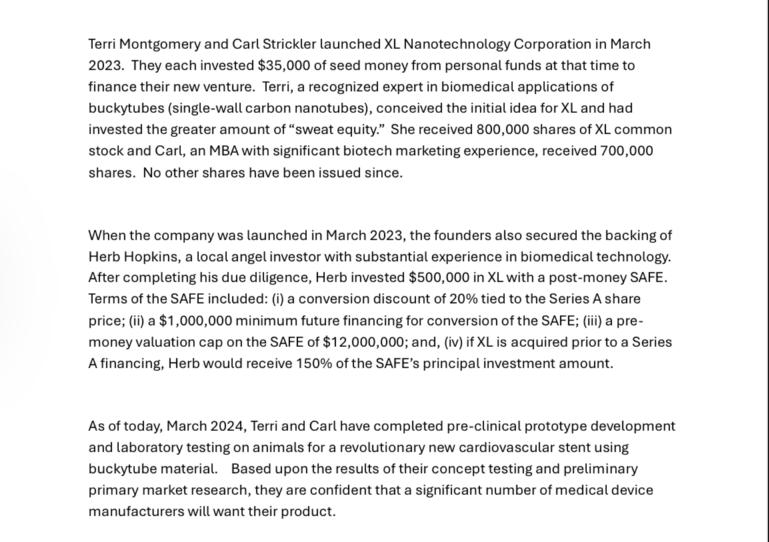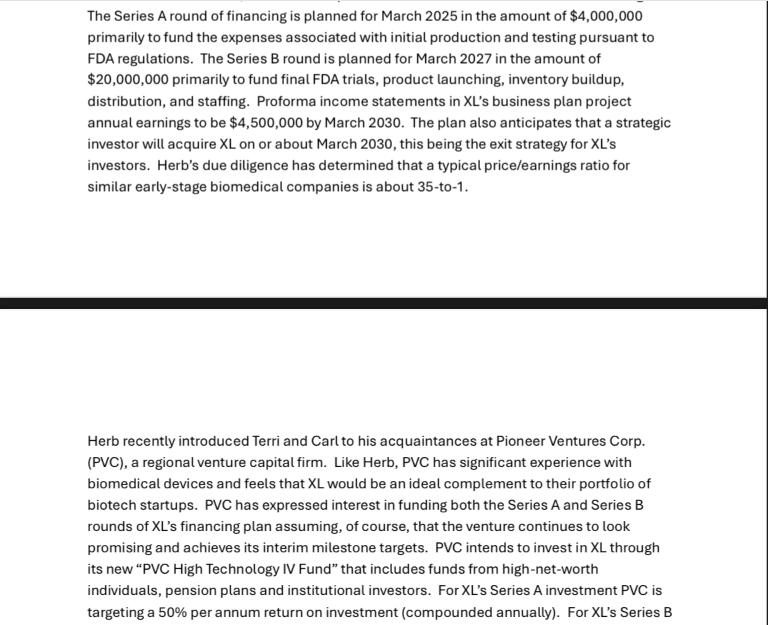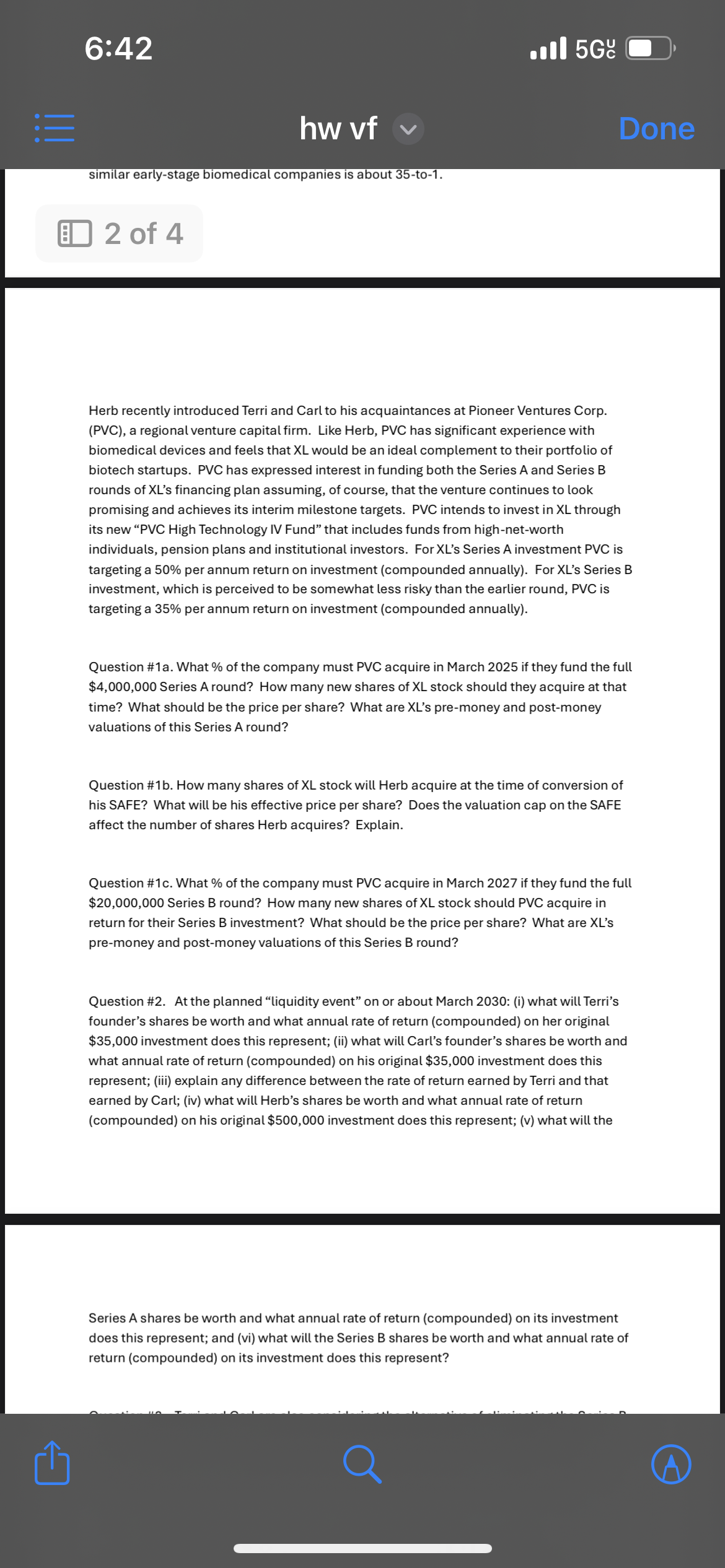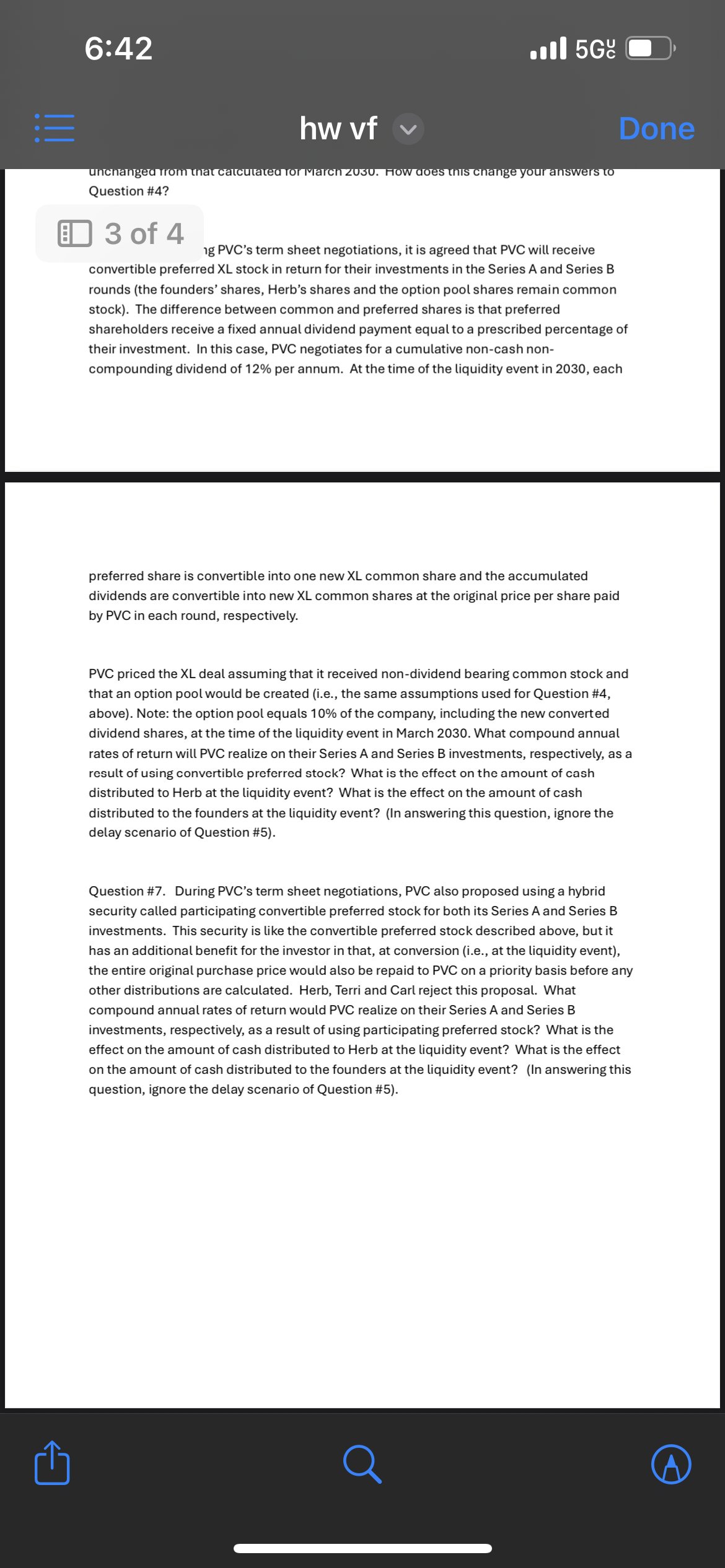Answered step by step
Verified Expert Solution
Question
1 Approved Answer
Terri Montgomery and Carl Strickler launched XL Nanotechnology Corporation in March 2023. They each invested $35,000 of seed money from personal funds at that





Terri Montgomery and Carl Strickler launched XL Nanotechnology Corporation in March 2023. They each invested $35,000 of seed money from personal funds at that time to finance their new venture. Terri, a recognized expert in biomedical applications of buckytubes (single-wall carbon nanotubes), conceived the initial idea for XL and had invested the greater amount of "sweat equity." She received 800,000 shares of XL common stock and Carl, an MBA with significant biotech marketing experience, received 700,000 shares. No other shares have been issued since. When the company was launched in March 2023, the founders also secured the backing of Herb Hopkins, a local angel investor with substantial experience in biomedical technology. After completing his due diligence, Herb invested $500,000 in XL with a post-money SAFE. Terms of the SAFE included: (i) a conversion discount of 20% tied to the Series A share price; (ii) a $1,000,000 minimum future financing for conversion of the SAFE; (iii) a pre- money valuation cap on the SAFE of $12,000,000; and, (iv) if XL is acquired prior to a Series A financing, Herb would receive 150% of the SAFE's principal investment amount. As of today, March 2024, Terri and Carl have completed pre-clinical prototype development and laboratory testing on animals for a revolutionary new cardiovascular stent using buckytube material. Based upon the results of their concept testing and preliminary primary market research, they are confident that a significant number of medical device manufacturers will want their product. The Series A round of financing is planned for March 2025 in the amount of $4,000,000 primarily to fund the expenses associated with initial production and testing pursuant to FDA regulations. The Series B round is planned for March 2027 in the amount of $20,000,000 primarily to fund final FDA trials, product launching, inventory buildup, distribution, and staffing. Proforma income statements in XL's business plan project annual earnings to be $4,500,000 by March 2030. The plan also anticipates that a strategic investor will acquire XL on or about March 2030, this being the exit strategy for XL's investors. Herb's due diligence has determined that a typical price/earnings ratio for similar early-stage biomedical companies is about 35-to-1. Herb recently introduced Terri and Carl to his acquaintances at Pioneer Ventures Corp. (PVC), a regional venture capital firm. Like Herb, PVC has significant experience with biomedical devices and feels that XL would be an ideal complement to their portfolio of biotech startups. PVC has expressed interest in funding both the Series A and Series B rounds of XL's financing plan assuming, of course, that the venture continues to look promising and achieves its interim milestone targets. PVC intends to invest in XL through its new "PVC High Technology IV Fund" that includes funds from high-net-worth individuals, pension plans and institutional investors. For XL's Series A investment PVC is targeting a 50% per annum return on investment (compounded annually). For XL's Series B 6:42 hw vf similar early-stage biomedical companies is about 35-to-1. 2 of 4 .III 5G Done Herb recently introduced Terri and Carl to his acquaintances at Pioneer Ventures Corp. (PVC), a regional venture capital firm. Like Herb, PVC has significant experience with biomedical devices and feels that XL would be an ideal complement to their portfolio of biotech startups. PVC has expressed interest in funding both the Series A and Series B rounds of XL's financing plan assuming, of course, that the venture continues to look promising and achieves its interim milestone targets. PVC intends to invest in XL through its new "PVC High Technology IV Fund" that includes funds from high-net-worth individuals, pension plans and institutional investors. For XL's Series A investment PVC is targeting a 50% per annum return on investment (compounded annually). For XL's Series B investment, which is perceived to be somewhat less risky than the earlier round, PVC is targeting a 35% per annum return on investment (compounded annually). Question #1a. What % of the company must PVC acquire in March 2025 if they fund the full $4,000,000 Series A round? How many new shares of XL stock should they acquire at that time? What should be the price per share? What are XL's pre-money and post-money valuations of this Series A round? Question #1b. How many shares of XL stock will Herb acquire at the time of conversion of his SAFE? What will be his effective price per share? Does the valuation cap on the SAFE affect the number of shares Herb acquires? Explain. Question #1c. What % of the company must PVC acquire in March 2027 if they fund the full $20,000,000 Series B round? How many new shares of XL stock should PVC acquire in return for their Series B investment? What should be the price per share? What are XL's pre-money and post-money valuations of this Series B round? Question #2. At the planned liquidity event on or about March 2030: (i) what will Terris founder's shares be worth and what annual rate of return (compounded) on her original $35,000 investment does this represent; (ii) what will Carl's founder's shares be worth and what annual rate of return (compounded) on his original $35,000 investment does this represent; (iii) explain any difference between the rate of return earned by Terri and that earned by Carl; (iv) what will Herb's shares be worth and what annual rate of return (compounded) on his original $500,000 investment does this represent; (v) what will the Series A shares be worth and what annual rate of return (compounded) on its investment does this represent; and (vi) what will the Series B shares be worth and what annual rate of return (compounded) on its investment does this represent? 1 6:42 hw vf .III 5G (compounded) on his original $500,000 investment does this represent; (v) what will the 3 of 4 Done Series A shares be worth and what annual rate of return (compounded) on its investment does this represent; and (vi) what will the Series B shares be worth and what annual rate of return (compounded) on its investment does this represent? Question #3. Terri and Carl are also considering the alternative of eliminating the Series B round and, instead, raising the total amount of $24,000,000 in the Series A round. They assume the investors in this priced round would require a 50% p.a. (compounded) rate of return. After analyzing this alternative, they decided not to pursue it. Why did they decide this? Question #4. Based on their prior experience, PVC believes that stock options will be needed as incentives to reward the existing XL employees and to recruit a management team for XL. They convince Terri and Carl to plan for the future creation of a pool of new XL shares for such option incentives equal, in total, to 10% of the company at the time of the liquidity event on or about March 2030. Given this plan to create a future pool of incentive stock options immediately prior to the liquidity event, recalculate your answers to Questions #1a, #31b, #31c and #2. Question #5. Immediately before the Series B round, it becomes apparent that the liquidity event will be delayed one year until March 2031 and that an additional $5,000,000 (i.e., a total of $25,000,000) will be needed in the Series B round. At the time when this delay becomes apparent, Herb's investment and the Series A round are already done deals and cannot be renegotiated. The future creation of a stock option pool, as described above, is included in XL's plans. The terminal value of XL on March 2031 is assumed to be unchanged from that calculated for March 2030. How does this change your answers to Question #4? Question #6. During PVC's term sheet negotiations, it is agreed that PVC will receive convertible preferred XL stock in return for their investments in the Series A and Series B rounds (the founders' shares, Herb's shares and the option pool shares remain common stock). The difference between common and preferred shares is that preferred shareholders receive a fixed annual dividend payment equal to a prescribed percentage of their investment. In this case, PVC negotiates for a cumulative non-cash non- compounding dividend of 12% per annum. At the time of the liquidity event in 2030, each preferred share is convertible into one new XL common share and the accumulated dividends are convertible into new XL common shares at the original price per share paid by PVC in each round, respectively. PVC priced the XI deal assuming that it received non-dividend bearing common stock and 6:42 hw vf ill 5G Done unchanged from that calculated for March 2030. How does this change your answers to Question #4? 3 of 4 ng PVC's term sheet negotiations, it is agreed that PVC will receive convertible preferred XL stock in return for their investments in the Series A and Series B rounds (the founders' shares, Herb's shares and the option pool shares remain common stock). The difference between common and preferred shares is that preferred shareholders receive a fixed annual dividend payment equal to a prescribed percentage of their investment. In this case, PVC negotiates for a cumulative non-cash non- compounding dividend of 12% per annum. At the time of the liquidity event in 2030, each preferred share is convertible into one new XL common share and the accumulated dividends are convertible into new XL common shares at the original price per share paid by PVC in each round, respectively. PVC priced the XL deal assuming that it received non-dividend bearing common stock and that an option pool would be created (i.e., the same assumptions used for Question #4, above). Note: the option pool equals 10% of the company, including the new converted dividend shares, at the time of the liquidity event in March 2030. What compound annual rates of return will PVC realize on their Series A and Series B investments, respectively, as a result of using convertible preferred stock? What is the effect on the amount of cash distributed to Herb at the liquidity event? What is the effect on the amount of cash distributed to the founders at the liquidity event? (In answering this question, ignore the delay scenario of Question #5). Question #7. During PVC's term sheet negotiations, PVC also proposed using a hybrid security called participating convertible preferred stock for both its Series A and Series B investments. This security is like the convertible preferred stock described above, but it has an additional benefit for the investor in that, at conversion (i.e., at the liquidity event), the entire original purchase price would also be repaid to PVC on a priority basis before any other distributions are calculated. Herb, Terri and Carl reject this proposal. What compound annual rates of return would PVC realize on their Series A and Series B investments, respectively, as a result of using participating preferred stock? What is the effect on the amount of cash distributed to Herb at the liquidity event? What is the effect on the amount of cash distributed to the founders at the liquidity event? (In answering this question, ignore the delay scenario of Question #5).
Step by Step Solution
There are 3 Steps involved in it
Step: 1

Get Instant Access to Expert-Tailored Solutions
See step-by-step solutions with expert insights and AI powered tools for academic success
Step: 2

Step: 3

Ace Your Homework with AI
Get the answers you need in no time with our AI-driven, step-by-step assistance
Get Started


